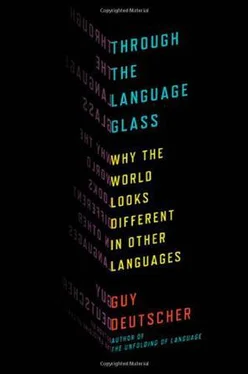Admittedly, Berlin and Kay’s evolutionary sequence differed from their predecessors’ in a few details. First, they refined Geiger’s prediction about yellow and green. Geiger thought that yellow always receives a name before green, but Berlin and Kay’s data revealed that some languages actually develop a name for green before yellow. So they added an alternative sequence and allowed for two different paths of evolution:
black and white › red › yellow › green › blue › black and white › red › green › yellow › blue
On the other hand, Berlin and Kay also attempted to make a few additions to Geiger’s sequence that eventually turned out not to have been improvements. They believed, for instance, that the universal sequence can be extended to other colors and claimed that brown is the color that always receives a separate name after blue and that either pink, purple, orange, or gray is always the color that comes after brown.
Notwithstanding such cosmetic differences, Berlin and Kay rediscovered Geiger’s 101-year-old sleeping beauty essentially unchanged and woke it up with a smacking great kiss. Of course, no one dreamed of calling it Geiger’s sequence anymore, as Geiger’s claims on it had been erased from the collective consciousness. Instead, the progression is now universally known as “Berlin and Kay, 1969.” But matters of copyright aside, the sequence that had dogged the debate in the nineteenth century suddenly trotted back on stage and demanded explanation: why do so many languages acquire color words in the same order, and why-underlying the variation-is there still so much similarity between the color concepts of different languages?
Berlin and Kay’s response to these questions swung the pendulum all the way back to nature. After half a century in which culture not only enjoyed the fruits of its rightful victory but was hailed as an absolute monarch with unlimited powers, Berlin and Kay went almost all the way back to Gladstone’s original belief that “our own primary colours have been given to us by Nature.” They did not deny, of course, that cultures can vary in how they set the boundaries between colors. But they argued that underlying the superficial divergence in boundaries, there is a far deeper communality, indeed universality, that was revealed in what they called the “foci” of the different colors.
Their notion of “focus” was based on an intuition that we all share, namely that some shades are better or “more typical” examples of a given color than others. There may be millions of different shades of red, for instance, but we still feel that some of these are redder than others. If you were asked to choose the best example of red from the chart in figure 6, it is unlikely that you would choose a bordeaux color like H5 or a pale pinkish red like D1. While both of these are undoubtedly red, you would probably point at some shade in the area of G1 as a better example. Similarly, we feel that a grassy green in the region of F17 is greener than some other greens. Berlin and Kay thus defined the focus of each color as the particular shade that people feel is the best example of this color.
When they asked speakers of different languages to point at the best examples of various colors, there was surprising cross-cultural similarity in the choice of foci. The case of blue and green was particularly striking. There are many languages that don’t make a distinction between green and blue and treat these as shades of one color. One of them is Tzeltal, a Mayan language from Mexico that uses one term, yaš , for the whole “grue” area. One might expect that when Tzeltal speakers are asked to choose the best example of yaš , they would point at something right in the middle of this range, a perfect turquoise halfway between green and blue, say around F24. But of the forty Tzeltal speakers who were tested, not a single one chose a turquoise focus. Instead, the majority pointed at clear green shades (mostly in the area of G18-20, which is a darker focus than what English speakers tend to choose for green, but nevertheless a pure green rather than a bluish green), and a minority of Tzeltal speakers pointed to clear blue shades as the best example of yaš (mostly in the area of G-H/28-30). Berlin and Kay concluded from this behavior that there was something natural and universal about our “green” and “blue” after all, since even speakers of languages that treat them as just one color still choose either clear green or clear blue as prototypical examples, whereas no one feels there is anything special about turquoise.
Since Berlin and Kay also found strong agreement about the foci of other colors among the informants from the twenty languages that they tested, they concluded that these foci were universal constants of the human race that are biologically determined and independent of culture. There is an inventory of exactly eleven natural foci, they claimed, that correspond exactly to the eleven basic colors of English: white, black, red, green, yellow, blue, brown, purple, pink, orange, and gray.
Berlin and Kay did not provide an actual explanation for the particular order in which the foci receive names. This, they said, was a matter for future research. But they did claim they knew where the explanation must be sought: in the nature of human vision. The only thing that culture was free to chose, they said, was how many of these foci receive separate names (and what labels to give them, of course). Once a culture has decided on a number, nature takes care of all the rest: it dictates which foci will receive names, it dictates in which order, and it draws the rough boundaries around these foci according to a predetermined design.

Like any pendulum worth its weight, received opinion finds it difficult to swing from one extreme position and settle directly in the middle, without first hurtling all the way to the opposite extreme. In the years following the 1969 revolution, lecture halls resounded with the new creed, and textbooks proclaimed-just as ardently as they had preached the diametrically opposed position in previous years-that color terms were natural and universal after all. Color was now hailed as the most striking example for the conceptual unity of mankind, and the language of color was declared as the trump argument in the wider nature versus culture debate, which was now being settled squarely in favor of nature.
Berlin and Kay’s book inspired many researchers to reexamine the concepts of color in many more languages, and in far greater detail and with greater accuracy than anything attempted before 1969. In the following decades, speakers’ intuitions about borders and foci in dozens of languages were systematically collected and compared. But as the number of languages grew from the twenty in Berlin and Kay’s original sample, and as the methods of elicitation became more sophisticated, it gradually emerged that the situation was less straightforward than Berlin and Kay had initially proposed. In fact, most of the categorical claims from 1969 about absolute universals in color naming had to be watered down in subsequent years.
To start with, it turned out that many languages contradict Berlin and Kay’s extensions to Geiger’s sequence, for they show that brown is not always the first color to receive a name after blue. What is more, later revisions had to abandon the claim that there are exactly eleven universal foci that correspond neatly to the English colors white, black, red, green, yellow, blue, brown, purple, pink, orange, and gray. In light of the new data, the alleged universal status of five of the foci-brown, purple, pink, orange, and gray-could no longer be defended, and the revised theory concentrated only on the six “major” foci: white, black, red, green, yellow, and blue. But even with these major colors, the foci turned out to be less uniform across languages than Berlin and Kay had initially assumed, as speakers’ choices in some languages strayed significantly from what were meant to be the universal foci. And finally, the larger database revealed languages that lump together under one concept combinations of foci that were deemed impossible in Berlin and Kay’s original model. There are languages, for instance, that have one color term that covers the light colors yellow, light green, and light blue. All in all, while some of the original rules formulated by Berlin and Kay still hold as strong tendencies among languages, hardly any of their claims remained intact as a universal law without exceptions.
Читать дальше












